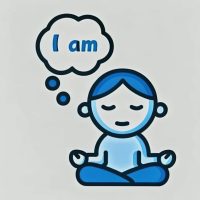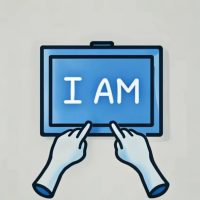
Question More, Action Knowledge.
Remember, at QMAK, we don’t just teach; we empower. We don’t just inform; we inspire. We don’t just question; we act. Become a Gold Member, and let’s unlock your child’s full potential, one question at a time.
Back to Mind Explorers
![]()
This game helps children explore their sense of identity and the various ways they define themselves.
By visualizing different endings to the sentence “I am,” children can recognize the many roles, characteristics, and labels they use to describe themselves. However, by erasing these additions and returning to just “I am,” children learn that their core sense of self is not dependent on these external definitions.
This exercise promotes self-reflection, flexibility in self-concept, and a deeper understanding of the difference between one’s essential being and the various identities they may adopt.
By regularly engaging with this practice, children can develop a more grounded and resilient sense of self, rooted in their inherent worth and potential.
Hey there, young writer!
Today, we're going to play a fun game called "The Erasing Game."
In this game, we'll be using our imagination to visualize words being written and then erased.
We'll start with the words "I am" and then think of different ways to complete the sentence. But here's the twist: after we add something to the sentence, we'll erase it and go back to just "I am."
This game will help us explore who we are and how we define ourselves.
Are you ready to start playing?
1. Have the child sit comfortably and close their eyes.
2. Ask the child to visualize the words “I am” in their mind. They can imagine the words being written on a piece of paper, a chalkboard, or a computer screen.

3. Encourage the child to think of a way to complete the sentence, such as “I am [their name],” “I am a [gender description],” “I am a [occupation],” or “I am [self-description].”
4. Have the child visualize the words they added being written after “I am.”

5. Now, ask the child to imagine erasing the words they just added, leaving only “I am.” If they visualized typing on a computer screen, they can imagine using the backspace key to erase the added part.
6. Repeat the process several times, encouraging the child to come up with different ways to complete the sentence and then erase them, always returning to “I am.”

7. After a few rounds, have the child open their eyes and take a moment to reflect on their experience.

To further explore the concept of identity and the power of self-definition, consider introducing your child to the book “I Am Enough” by Grace Byers.
This beautifully illustrated book delivers a message of self-acceptance, self-love, and the inherent worth of every individual. Through simple, affirming statements, the book encourages children to embrace their unique qualities, celebrate diversity, and recognize that they are enough just as they are.
By engaging with this empowering and uplifting story, children can develop a stronger sense of self-esteem, resilience, and connection to others, while learning to let go of limiting self-definitions and embrace their boundless potential.
1. What is the main message of the book?
a) You should try to be like others
b) You are valuable just as you are
c) Only certain people are enough
d) You need to change to be accepted
2. In the book, what is the girl compared to when standing tall?
a) A mountain
b) A skyscraper
c) A tree
d) A giraffe
3. What does the book say about the girl’s voice?
a) It should be quiet
b) It’s meant to be heard
c) It’s not important
d) It should sound like others
4. How does the book describe the girl’s ability to learn?
a) She can’t learn new things
b) She should only learn easy things
c) She can learn anything
d) Learning isn’t important
5. What does the book say about helping others?
a) It’s a waste of time
b) Only help those who can help you back
c) Helping others is part of who we are
d) Don’t help anyone
6. How does the book describe the girl’s relationship with nature?
a) She’s afraid of nature
b) She’s part of nature
c) Nature is unimportant
d) She should avoid nature
7. What does the book say about the girl’s dreams?
a) Dreams are silly
b) Only some dreams matter
c) Her dreams are meant to be chased
d) She shouldn’t have dreams
8. How does the book describe differences between people?
a) Differences are bad
b) Everyone should be the same
c) Differences make us special
d) Only some differences are okay
9. What does the book say about the girl’s ability to stand up for herself?
a) She shouldn’t stand up for herself
b) Only adults can stand up for themselves
c) She can stand up for herself
d) Standing up for yourself is wrong
10. How does the book end?
a) With the girl feeling sad
b) With the girl wanting to be someone else
c) With the girl knowing she is enough
d) With the girl giving up
1. b) You are valuable just as you are
2. c) A tree
3. b) It’s meant to be heard
4. c) She can learn anything
5. c) Helping others is part of who we are
6. b) She’s part of nature
7. c) Her dreams are meant to be chased
8. c) Differences make us special
9. c) She can stand up for herself
10. c) With the girl knowing she is enough
Verse 1:
Write it down, then erase it clean
“I am” is more than what it seems
Add a word, then take it away
Who are you at the end of the day?
Pre-Chorus:
I am strong, I am shy
I am short, I am high
Erase it all, and what do you see?
Just “I am”, that’s the key
Chorus:
I am, I am, two words so small
Yet they contain it all
Write and erase, again and again
I am, I am, where we begin
Verse 2:
I’m a student, I’m a friend
I’m an artist, without end
But when those words fade away
“I am” is all that’s here to stay
(Pre-Chorus)
(Chorus)
Bridge:
Beyond the labels, beyond the names
We’re playing the Erasing Game
Finding the essence of who we are
Two words that take us near and far
(Chorus)
Outro:
Open your eyes, what do you know?
You’re more than the words that come and go
I am, you are, we all can be
Whatever we choose, eternally

Remember, at QMAK, we don’t just teach; we empower. We don’t just inform; we inspire. We don’t just question; we act. Become a Gold Member, and let’s unlock your child’s full potential, one question at a time.